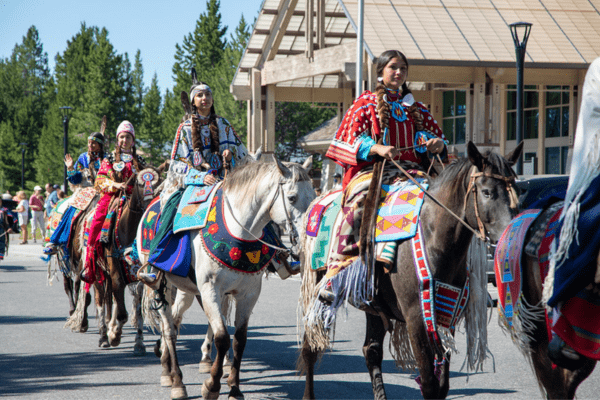Tracing its History and Legacy On its journey across the Palouse’s fertile plains, an elegant Nez Perce Horse majestically trots into view to provide a window into their rich history and legacy as it showcases indigenous heritage and equestrian distinction.
Originating from a meticulous crossbreeding between the resilient Akhal-Teke and the distinctively speckled Appaloosa, the breed emerged as a treasure of the Nez Perce tribe, nestled in the heart of Idaho.
An offspring of careful breeding between an Akhal-Teke and an Appaloosa, this breed became an invaluable treasure of the Nez Perce tribe located in Idaho.
Familiarly and affectionately known by their tribe as “Ma’amins,” these horses boast not only an eye-catching aesthetic with vibrant spots but also a graceful yet quick gait, positioning them to become champions of endurance, agility, and long distance treks.
Proliferating across Palouse grasslands like mushrooms in autumnal bloom, they became treasured members of society that neighbors, businesses, intrepid explorers all sought them out as assets of value – not simply as beasts of burden but as entities sought-after by neighboring tribes or business entities or those looking for long distance adventures alike.
Reviving the Nez Perce Horse: A Tale of Tradition and Triumph
Unquestionably, the Nez Perce Horse boasts an extraordinary legacy woven through generations of tradition, breeding excellence, and unrelenting spirit of its Nez Perce people; inviting us all into an epic tale of survival and revival.
Commemorated Initiative in 1951:
In 1951, Lapwai Idaho saw the unveiling of an initiative known as the Nez Perce Horse Registry (NPHR), an ambitious attempt at uniting robust genetics from Akhal-Teke and Wallowa Appaloosa herd. This endeavor stemmed from an urgent desire to revive equine culture lost since colonization; revitalizing traditional horsemanship practices once vigorously employed by Nez Perce.
Financial and Tribal Solidarity:
Spearheaded and funded by the Nez Perce tribe with assistance from First Nations Development Institute and Department of Health and Human Services, this project sought to revitalize the iconic Nez Perce Horse breed. Efforts led to their recovery from pure Minam lineage on a pastoral ranch located within Wallowa Valley’s tranquil landscape.
Present-Day Breed Characteristics:
The contemporary Nez Perce Horse stands out for its long back, slim physique and narrow shoulders and hindquarters compared with more robust Quarter and stock horses commonly found in Western America – providing a distinctive and stylish alternative within equine society.


Ancient Ties and Speculations:
Equine presence in Americas was first brought over by Spanish colonizers around 1730 and quickly revolutionized Plains Indian lifestyles. Furthermore, Appaloosas–linked with Nez Perce Horse lineage — appear frequently throughout Asian and Chinese pictographs, prompting speculation of transcontinental connections among equine herds.
Anthropological theories also suggest Pacific Northwest tribes like those known as Nez Perce may have crossed ancient land bridges near Bering Straits that suggest older interconnected histories than previously acknowledged.
Akhal-Teke: The Metallic Progenitor
Hailing from Turkmenistan, the Akhal-Teke breed of horse is famed for its “metallic” coats and endurance, making an imposing debut as the Nez Perce Horse lineage’s metallic progenitor.
Coat colors such as palomino, buckskin, dark bay and dun combine perfectly with Appaloosa features to produce beautiful Nez Perce Horses that often appear with palomino or buckskin faces along with characteristic Appaloosa mottling patterns or spot patterns adorning their features resulting in Nez Perce Horses which often appear palomino or buckskin visages covered by Appaloosa mottling or spot patterns on their faces – perfect precursors!
This extraordinary story from historical decline to deliberate breeding and resurgence of the Nez Perce Horse not only illustrates their physical and genetic journey but also symbolizes the determination and resilience of its native people – as embodied by this beautiful symbol, heritage, endurance, tradition, gallops gracefully forward into its future to ensure that stories, beliefs and spirit of its tribe continue riding through every fiber.


The Nez Perce Horse Today: Symbols of Resilience
Today, the Nez Perce Horse stands as an inspiring symbol of Native American culture and history. They are revered not just for their physical attributes but also as bearers of a sacred legacy tying together past, present and future of Nez Perce people.
Events like Chief Joseph Trail Ride annually remember and perpetuate the memory and unwavering endurance of both tribe and horse alike.
Preserving the Legacy: Towards a Sustainable Future
As society forgets the primal and powerful relationship between humans and horses, the Nez Perce Tribe upholds an undeniable bond with their beloved companions.

Through sustainable breeding programs, cultural events, and educational initiatives they continue to honor their legacy while passing down knowledge that ensures future generations can witness its beauty, understand its historical importance, and carry on its traditions through future generations.
Through valleys and over mountains, the Nez Perce Horse continues to echo with tales of valor, despair, and ever-enduring hope, leaving behind an invaluable legacy that will continue to be remembered by generations to come.

